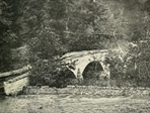Breaking the Confederate Line at Antietam
Question

Which Union regiments fought at Antietam? Who was the Union general who led the attack across the bridge at Antietam on Confederate lines and how many times did he charge before breaking through?
Answer
The battle at Antietam Creek on September 17, 1862, ended Confederate General Robert E. Lee’s first invasion of the North. The Confederate Army of Northern Virginia faced Union General George B. McClellan’s Army of the Potomac near Sharpsburg, Maryland; by the end of the day, 6,000 Americans lay dead or dying and another 17,000 were wounded. It remains the bloodiest single day in American history.
The Confederate Army fielded two corps (Longstreet’s and Jackson’s), organized into nine infantry divisions and a cavalry division and comprising more than 130 individual regiments, together totaling more than 38,000 men. The Union Army of the Potomac fielded six corps (I, II, V, VI, IX, and XII) organized into 18 infantry divisions and a cavalry division; more than 191 individual regiments numbering some 75,000 federal troops fought in the battle at Antietam. (An exhaustive list of every corps, division, brigade and regiment, along with the officers that commanded them—known as the order of battle—can be found in Stephen Sears’ Landscape Turned Red: The Battle of Antietam, pp. 359-372.
Union General Ambrose Burnside’s IX Corps held the left side of the Federal line south of town, where a single bridge spanned Antietam creek. Burnside’s men spent hours attempting to cross the narrow bridge in the hopes of flanking the Confederate line on the western bank. (The flanking maneuver, in which the attacker attempted to get around the side of the defender’s line and attack it at right angles, formed a critical part of Civil War military tactics. Because a flanked line was extremely vulnerable to enemy fire, and because it could not level its own return fire very effectively, Civil War commanders repeatedly tried to flank their opponents while trying to avoid having their own lines flanked.)
Though Antietam creek was shallow enough to be forded at several places, Burnside focused his corps’ attacks on the lone bridge near the Rohrback farm—a bridge that would later bear his name, thanks to his troops’ bloody attempts to cross it. Because the bridge was only twelve feet wide, a relatively small number of Confederate defenders was able to prevent Burnisde’s entire corps from crossing for hours. Beginning at around 10 a.m., two Georgia regiments held off attacks by some 12,500 Union soldiers.
Finally, at around 2 p.m., two Northern regiments hand-picked for their toughness and promised a ration of liquor after capturing the bridge, attempted to cross at a run. The 670 men of those regiments charged down the hill facing the bridge and fanned out behind cover on the eastern banks; the Georgian defenders, exhausted and nearly out of ammunition after three hours of fighting, began to withdraw. In a rush, color-bearers led the two units across the bridge and finally secured a foothold on the western shore. More than 500 Federals and 120 Rebels had died in the fighting there. George McClellan, commanding general of the Union forces at Antietam, later received significant criticism for the uncoordinated attacks along the Federal line, for not pushing to cross the creek more quickly, and for failing to exploit the crossing effectively. Most observers judged the battle at Antietam a draw; McClellan had ended Lee’s invasion of the North, but the rebel army remained an effective fighting force. Lincoln and others viewed the battle as a lost opportunity to end the war.
Burnside’s ineffective leadership at the bridge during led McClellan to write to his wife little more than a week later describing him as “very slow” and “not fit to command more than a regiment.” McClellan’s evaluation may have been correct; nevertheless, McClellan’s own performance at Antietam led to his removal by Abraham Lincoln on November 7, 1862. The Army of the Potomac’s next commander would be none other than Ambrose Burnside, who led the Union forces in the even more disastrous and lopsided defeat at Fredericksburg that December.
For more information
The War of the Rebellion: a Compilation of the Official Records of the Union and Confederate Armies, U.S. War Department, 1880-1901, Making of America, Cornell University Library.
"Order of Battle." Antietam on the Web, 2010.
Kennedy, Frances H., ed. The Civil War Battlefield Guide. 2nd ed. Boston: Houghton Mifflin Co., 1998.
Bibliography
Eicher, David J. The Longest Night: A Military History of the Civil War. New York: Simon & Schuster, 2001.
Sears, Stephen. Landscape Turned Red: The Battle of Antietam. New York: Houghton Mifflin Company, 2003.
Waugh, John. Lincoln and McClellan: The Troubled Partnership between a President and His General. New York: St. Martin's Press, 2010.
